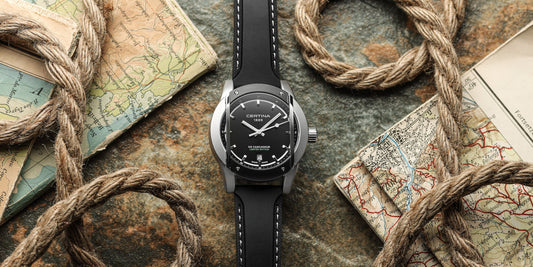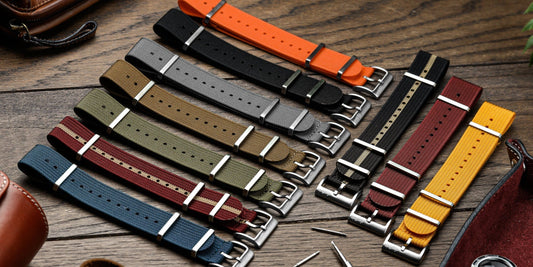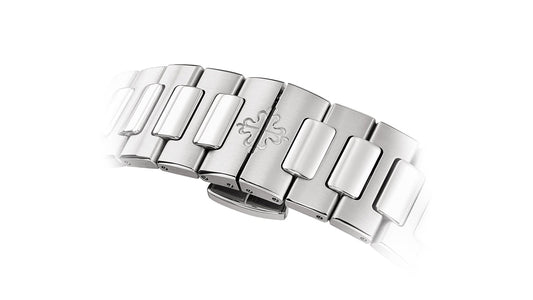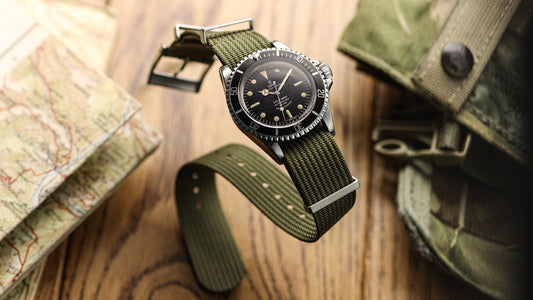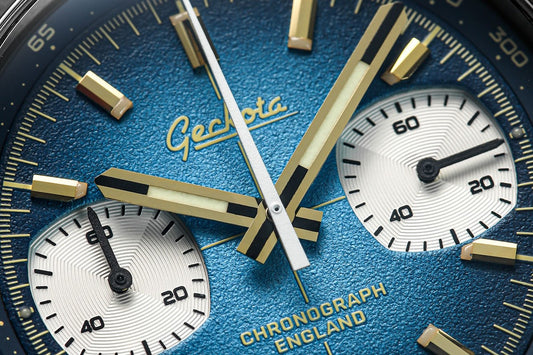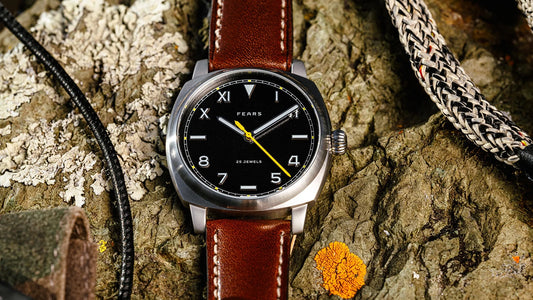Leather watch straps are timeless and stylish. In this article, read all about leather watch bands and get ideas for choosing, buying and using yours…
General tips for choosing your watch strap
There’s no definitive guide or rulebook to choosing and wearing your watch and strap combination, or choosing a new strap to accompany a favourite timepiece. The following ideas, which complement those in a previous section, should give you some inspiration:
First, decide whether genuine leather is right for what you plan to do with your watch. It might not be if you'll spend all day in the water, or outdoors in hot-and-humid climates. In that case a speciality leather strap, or even a different material, may be more suitable.
Decide which type of leather watch strap you want
Once you’ve decided on genuine leather (good choice, by the way!), choose which type of leather watch band you want. If buying off the shelf, you’ll also need to make sure your watch has removable spring bars. If considering leather ZULU straps, make sure the clearance between the spring bars and watch case is sufficient – not all are. Similarly, if your watch has fixed lug bars, your leather strap choices will be more limited. It’s a nice problem to have if you’re fortunate enough to own an ex-military watch with solid lug bars, such as an ex-SBS Submariner, Seamaster 300 or CWC diver).
Finally, match the watch-end width of shortlisted strap(s) to the length of the spring bars on the watch. These are typically between 18 mm and 24 mm and can easily be measured if you aren’t sure. Ask your watch supplier nicely and they might even send you a handy gauge to check with.
As ever with straps, we don’t recommend fitting watch straps (leather or otherwise) that are too small for the lug width. It rarely looks good, even if Sean Connery got away with an undersized nylon band on the 20mm lug bars of that famous Rolex Submariner in Goldfinger.

Choose the correct length for your wrist
Having done this, make sure your chosen strap is the correct length to fit your wrist (including allowance for the length of the watch case). Strap length may be listed as Short, Regular or Long, with regular straps usually designed for a wrist circumference between 6.5” (165 mm) and 8” (203 mm).
As mentioned elsewhere, the best leather strap suppliers will welcome the opportunity to help you choose the most suitable strap style, colour, detailing, width and length for your requirements. Especially if they are microbrands, they are watch fanatics like you, so they will understand.
Colour and textural contrast
When it comes to pairing a strap with a timepiece, you can either match or contrast the colour and detailing of your strap to your watch.
Contrasting is likely to be easier. That’s because most watches feature a variety of colours for primary elements (such as the face and case) and subsidiary elements (such as bezel, hands and chronograph dials). If you don’t believe us, take a look at even the most understated watch and you’ll probably discover all kinds of subtle variations in colour and texture.
For best results…
Very often, with leather straps, the best results are achieved with a broadly complementary overall strap colour that suits the watch. And detailing (stitches, rivets and buckles) that pick up the colour of a subsidiary element. Now let’s see how strap and stitching colour complements a couple of classic watches worn on leather:
Take Omega’s limited edition De Ville Tresor, with its dark blue face and stainless steel case, bezel and hands; for this timepiece, dark blue alligator-pattern leather looks superb.
Now let’s take to the air with IWC’s iconic Big Pilot’s Watch Reference 5009 in stainless steel. A quick look at the latest IWC brochure shows how good this timepiece looks on a classic black alligator strap. Perfect co-ordination is achieved because the two rivets at the watch ends of the strap (spot the 1940s B-Uhr reference) perfectly match the watch’s stainless steel case as well as contrasting impressively with the black leather. Despite being a functional tool watch, this combination of IWC and timeless black leather is guaranteed to work anywhere from an A-380 cockpit to dinner at Dubai’s Burj Al Arab Jumeirah during a layover.
Thirdly, consider the Panerai Luminor Marina 1950 with its chocolate brown face, titanium case and brown leather strap. It just looks so right. It’s the same with white stitching with a dark brown or black leather strap. And what about light coloured alligator-effect texturing on our own handmade Zim Italian leather strap, and the way it picks up the gold-colour lettering on our K3’s dial?
Stunning with a suit or jeans
Any of these combinations would look good with a business suit, or jeans and a smart-casual shirt. That’s the beauty of leather. It’s a natural material that fits in anywhere and gains character with every wearing until it becomes an inseparable partner on life’s adventure...
And of course, though super-luxury watches demonstrate these principles so seductively, they also apply to microbrand watches at a completely different price point. In fact, there’s a strong case for putting a stunning luxury strap on a modest watch to lift it up a level in the eyes of any admirer. You should try it!

The importance of leather watch strap hardware
As well as choosing the broadly correct colour for your leather watchstrap, and any complementary or contrasting stitching, don’t overlook the importance of watch strap hardware. It could be as simple as choosing a buckle colour that picks up an accent colour from the watch; or you might choose to maintain historical correctness with, for instance, a brass-colour double-riveted leather strap to go with your original WW2 German Fliegeruhr – or our own K-01 B-Uhren homage watches.
Textural contrast matters too. How about stylistically aligning a strap’s texture and pattern with a dominant characteristic of your watch. For instance, double-ridge padding and associated three-line stitching is a lovely detail. It works particularly well with rectangular-faced watches such as the Audemars Piguet Tourbillon III, Roger Dubois Golden Square Dual Time, Rolex Prince Brancard or Longines Doctor’s Watch.
Your personality
We make no apology for returning to your mood and personality throughout this article. Why? Because it's so important! Are you low-key, maybe a little reserved and definitely conservative (with a small ‘c’)? If so, you’ll probably gravitate to traditional classic leather two-piece straps in muted earth tones with subtle graining.
On the other hand, if you’re extrovert, outgoing and a bit of a maverick, how about a leather ZULU style strap? Of course, if you believe the only true military band is nylon, make that a chunky ‘alligator grain rugged strap’. Or how about something bright in blue, red or orange leather with high contrast stitching. We noticed! You’ve arrived!
Compatibility with your watch.
The vast majority of men’s watches are compatible with aftermarket replacement straps. A few have completely integrated bracelets, which preclude swapping out the factory-fitted item for a replacement leather strap. Similarly, a few watches require you to return to the manufacturer or authorised stockists for compatible straps. Once you understand which of these applies to your watch, you can plan your strap change. Do remember that specialist leather watch strap makers can craft bespoke straps to your specific requirements.
Matching leather watch straps to specific types of watch
There really are so many different ways to match a replacement watch strap to a watch. No wonder we find ourselves returning to the possibilities and challenges from several different perspectives. This time we’ll look at it from the watch-type point of view. Specifically, we’ll look at dress watches, pilot watches, chronographs and divers (sports watches).
Dress watches
A Watchuseek forum thread back in 2009 discussed this question: ‘What makes a dress watch?’ As ever, opinions differed, but ‘slim, analogue, simple dial, metal case, leather strap (possibly with a deployment clasp for a fitted look) and “modest” dial diameter were mentioned. Meanwhile, another contributor counselled the importance of differentiating between ‘good looking’ and ‘dressy’. Why? Because there are lots of good looking watches that aren’t dressy. And make sure the watch goes well with your suit.
Many aficionados advocate a dress watch (complete with a suitable leather strap, almost certainly a classic two-piece leather strap). This, they maintain, should be the basic element in a watch collection. Why? Probably because, if you're only going to have one watch. It had better be wearable in as many business and social situations as possible. And to accompany it, a shiny-but-not-tacky-finish black strap in crocodile or alligator is an extremely safe bet. It’s also a great look.

Pilots’ watches
Again, there are differences of opinion, but, bearing in mind the role of the Germano-Swiss 1930s–1940s B-Uhren the following is a good starting point. A large face (40–55 mm) is important, with a high visibility, high contrast dial and hands (usually white on black or black on white). Simple, ultra reliable movements with no subdials or complications (except for a hacking movement for pre-takeoff time synchronisation) are usual. And an uncluttered ‘low information’ watch face with ‘Delta and two dot’ 12 o’clock marking for easy low-light orientation. And remember large, clear well-lumed hands.
That said, a whole class of pilot watches has emerged since WW2, which include slide rules, chronograph functions, time zone capabilities and all manner of other features and complications to delight real and wannabe pilots.
Chronographs
We’ll quote Wikipedia here:
A chronograph is a specific type of watch that is used as a stopwatch combined with a display watch. A basic chronograph has an independent sweep second hand; it can be started, stopped, and returned to zero by successive pressure on the stem.
Chronographs (‘racing watches’) traditionally have strong links with aviation and motorsport. Not surprisingly, this has important implications for the types of leather strap that are often worn with them. For instance, for that 60s and 70s retro motorsport look, a rally-style perforated or punched leather strap looks great.
Even where the watch has a high-tech look, more akin to a vehicle dashboard than a watch, stylish leather straps have a place. Remember the now classic Le Mans movie of 1971 and the square-dialled Heuer Monaco watch on the late Steve McQueen’s right wrist?
The story goes that after becoming friends with adviser and stunt driver Jo ‘Seppi’ Siffert on the Le Mans set, McQueen insisted on looking like the Swiss ace – down to the same watch and white Heuer-emblazoned overalls. Tragically, Siffert died shortly after the film was made, in 1971, during a non-championship race at Brands Hatch. He was the first racing driver (and possibly even the first professional sportsperson) to have an ambassador contract with a watch company (Heuer). He normally wore an Autavia 1163t Chronomatic (a much more suitable chronograph than the Monaco for racing drivers). The distinctive white-dialled Autavia is now reverentially called the ‘Siffert Heuer’ by fans. It’s the watch on Siffert’s wrist in many contemporary photographs, including shots taken while filming Le Mans. According to reported interviews with Jack Heuer, though McQueen wanted the Autavia, the Monaco (launched in 1969) was the only watch the props department had three identical examples of – for filming, still photography and backup.
So McQueen wore the Monaco calibre 11, complete with black alligator leather strap, and an icon was created. This has since become known as the ‘Le Mans Watch’ – and there wasn’t a perforation or cut-out in sight! Subsequently, Heuer’s 1133B model, the so-called ‘McQueen Monaco’ has become a sought after collectors’ item.
Of course, if you’re fortunate enough to own a Monaco, or fancy a new one (they’re still in the TAG Heuer range), you could easily retrofit a rally-style strap! Or maybe not!

Divers’ watches
See our last article for a detailed discussion about divers’ watches. As we explained there, ISO 6452 and other standards stipulate various criteria and performance requirements. Quoting Wikipedia again:
A diving watch, also commonly referred to as a diver's or dive watch, is a watch designed for underwater diving that features, as a minimum, a water resistance greater than 1.0 MPa (10 atm), the equivalent of 100 m (330 ft).
The fact that the diver is, by definition, used in water, means leather straps are far from ideal. That’s why watch and strap manufacturers have experimented with naturally water-resistant straps. The materials used have included seal leather, stingray and sharkskin (believed more water resistant than cowhide) as well as waxed or oiled cowhide straps. More recently, leathers have been treated with proprietary processes. These include those of Austrian manufacturer Hirsch, which bestow 100 m water resistance. Or the KODIAK process, which reportedly allows extended continuous immersion for up to 24 hours.

Your turn to get into leather
So there you have it, our brief primer on genuine leather watch straps and some ideas to get you thinking about your next (or your first) leather strap.
Have we whetted your appetite for this versatile and stylish natural material? Maybe we’ve prompted you to dig out an old leather strap and try it on your latest wear? Or perhaps a lovely tan leather ZULU would breathe new life into an old diver or rarely worn chronograph?
However you like to enjoy your watch collection, leather straps are stylish, timeless and ridiculously inexpensive for how much they can transform a watch’s personality. There’s never a wrong time to start, or add to, your collection. And get even more pleasure from your favourite watches.
Visit our leather strap section and ‘get into leather’ (in the nicest possible way, of course) with a simple leather band, perforated rally strap or the luxurious, practical leather ZULU you’ve always fancied!




